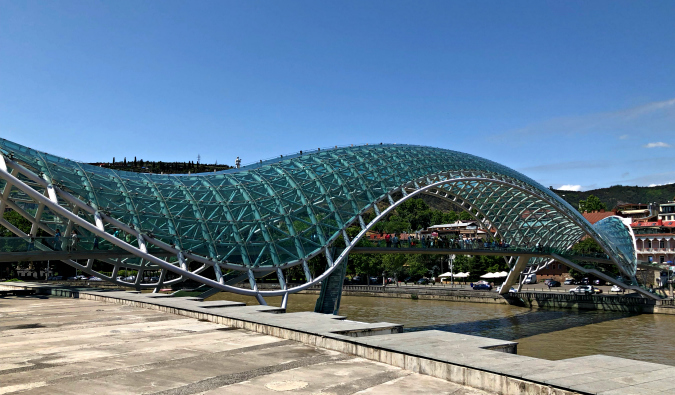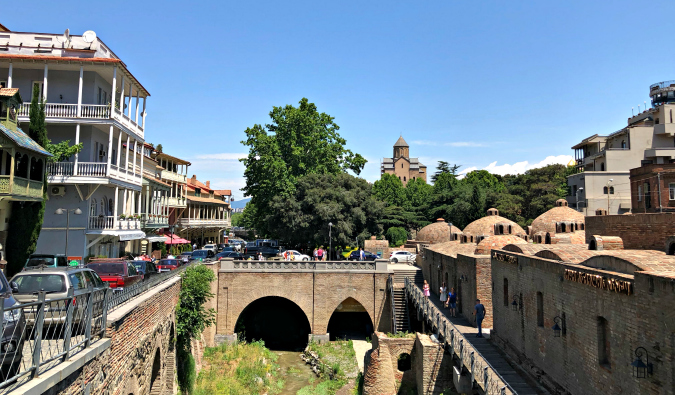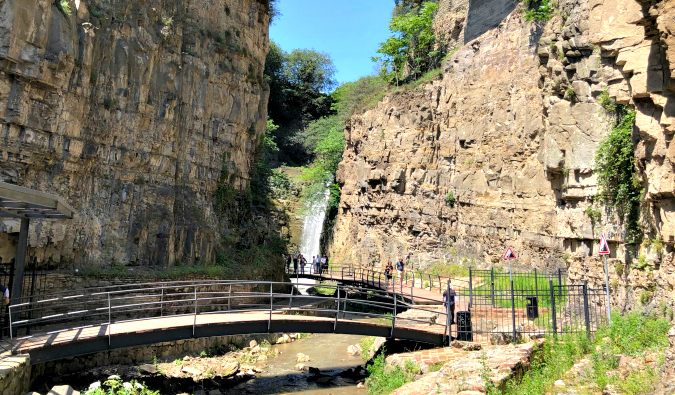
Post: 9/12/18 | September 12th, 2018
“When did you first hear of Georgia?” Mako asked after a long drag from her cigarette. She was a Georgian tour guide helping my friend Dave, who was also in the country. We were drinking wine outside Fabrika, an old Soviet fabric factory now converted into a multi-use center with bars, restaurants, co-working spaces, shops, artist studios, and a hostel.
“Hmm…” I replied. “That’s a good question. On some level, I’ve known about Georgia for a long time, because I know my geography. But as a place that was more than just a name on a map, I would have to say it’s only been in the last few years — when I started thinking of more unique and off-the-beaten-path places to visit — that I really thought ‘Hmm, Georgia? That could be interesting!’”
When I escaped London for a trip to Azerbaijan, I added nearby Georgia to the itinerary too. Friends had spoken highly of the country, and I wanted to see its mountain towns, beaches, and historic cities, and to taste the food and wine I had heard so much about. I wanted to learn its history, peek behind the veil, and see what this place was really about.
My original plan was to spend about a little over a week there, hitting some of the highlights and whetting my appetite for another trip (to me, a week in a country is just never enough time).
But, after a change in plans that required me to head home earlier than expected, I only had enough time to see the capital of Tbilisi.
From the moment I got off the bus from Azerbaijan, I was in love. Yes, that’s a cliché. But sometimes a destination just hits you in the face the right way, and everything just clicks. The energy — the essence — of where you are just flows through your body, and you feel like you’ve come home to a place you didn’t even realize was your home.

As if a part of you had always been there, and you were simply returning to make yourself whole again.
Over the next few days, that feeling only increased as I actually began exploring the city.
Before arriving, I had pictured a grimy old city with crumbling, ugly Soviet-era buildings and graffiti. In my mind, it was still frozen in the immediate fall of the Soviet empire.
Instead, I found a beautifully preserved Old Town with cobblestone streets and stunning buildings with ornate balconies; lots of spacious parks, wide streets, eclectic artist spaces, and funky cafés; and modern and sometimes futuristic architecture. It was a lot more like Europe than I had anticipated.

I spent my first day wandering the old town. I gazed at the Metekhi Church with its giant equestrian statue of King Vakhtang Gorgasali overlooking the Mtkvari River. This is where the king built his palace when he made Tbilisi his capital in the fifth century. (Legend has it that he founded Tbilisi while hunting and discovered the sulfur baths, but a city existed here long before he came along! He just revived it.) The simple, domed-shaped brick building is popular with locals, as legend says the fifth-century martyr St. Shushanik was buried here.
From there I walked across the bridge, toward the famous sulfur baths, a collection of brick-domed buildings containing subterranean bathhouses. These baths helped make Tbilisi famous, as the waters are claimed to help soothe symptoms in chronically ill patients, like arthritic pain or poor blood circulation. There used to be 63 of these baths in Tbilisi, but there are only a handful left now. They are still wildly popular, though I don’t see the charm in smelling like rotten eggs. But hey, I’m a weirdo, so what do I know?

These bathhouses straddle a small river that feeds them and then meanders through a canyon that you can follow to the amazing Dzveli Tbilisi sulfur waterfall. There, the sound of the city melts away, and you feel more like you’re in a national park than a national capital.
I wandered some more and located the entrance to Tbilisi’s gigantic National Botanical Garden, where I found a zip line, tons more waterfalls and rivers to swim in (which, given the high heat during my visit, were being well utilized by locals), hiking paths, and flowers and shrubbery. Amidst this peace, I often had to remind myself that I was in a chaotic major city and not some little quiet mountain town.

From there it was up to the Narikala Fortress, which dominates the skyline. Dating back to the fourth century, it was once a Persian citadel. Most of the walls were built in the eighth century, but in 1827 an explosion of Russian ammunition stored there wrecked the whole thing. The cliffs the ruins are on offer the best views of the entire city. You can see for miles, which is probably why the site was chosen for the citadel. A cable car connects it with Rike Park on the other side of the Mtkvari River.
The next day, I explored the city’s history museums (which, to my surprise, had a good amount of English translations). I highly recommend the Georgian National Museum, which has a detailed exhibit on the country’s history. There’s also the Nikoloz Baratashvili Memorial House-Museum, which houses materials related to the life and work of the romantic poet, period furniture, folk musical instruments, paintings, and lots of history about 19th-century Georgia. Then, in a former synagogue, there’s the David Baazov Museum of the History of the Jews, which spotlights the history of Jews in Georgia (which has a very close relationship with Israel).
However, after having just hiked a lot in Azerbaijan, walking in the stifling summer heat of Tbilisi wasn’t exciting me that much. I was tired. So, after a day and half of sightseeing, I found myself indoors drinking tea, writing, consuming a (un)healthy amount of wine, gorging on food at Fabrika, talking to other travelers, getting to the know the staff at a local coffee shop, and hanging out with Dave.
I can’t say I really know Tbilisi. Sure, I can get around the subway now. I have an idea of what things cost. I learned about the city and country. I met some cool people.
But do I know it? No, not in the way I know New York or Paris or Bangkok or a thousand other places.
But I feel like I know it.
Tbilisi is a city bursting with activity. A city of art and history. Of enjoyment. Of an energy that seemed to say, “Come enjoy the good life over wine. Don’t fret over things — just be.”
That’s an energy that I love and felt when I got off the bus.
And though it’s terrible to end a travel article with the cliché “I can’t wait to go back,” I honestly can’t wait to go back.
I felt at home there.
And everyone loves the feeling of returning home.
Book Your Trip to Tbilisi: Logistical Tips and Tricks
Book Your Flight
Find a cheap flight to Tbilisi by using Skyscanner or Momondo. They are my two favorite search engines. Start with Momondo.
Book Your Accommodation
You can book your hostel in Tbilisi with Hostelworld. If you want to stay elsewhere, use Booking.com as they consistently return the cheapest rates. (Here’s the proof.)
Don’t Forget Travel Insurance
Travel insurance will protect you against illness, injury, theft, and cancellations. I never ever go on a trip without it. I’ve been using World Nomads for ten years. You should too.
Need Some Gear?
Check out our resource page for the best companies to use!
Want More Information?
Be sure to visit our robust destination guides for even more planning tips!
The post Finding Love in Tbilisi in 72 Hours appeared first on Nomadic Matt's Travel Site.
No comments:
Post a Comment